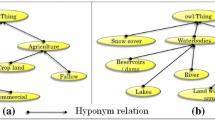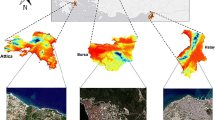Abstract
The availability of satellite imagery to "domain" experts, along with advancements in image processing and analysis techniques, has revolutionized numerous fields, enabling better understanding, planning, and management of our planet's resources. However, formalizing the knowledge gained from domain experts is essential for preserving, sharing, and leveraging their expertise. In this context, knowledge representation methods like ontology play a significant role in the development of applications based on satellite image analysis. Land cover labeling is one of the significant applications of satellite image analysis and plays a vital role in various domains by providing valuable information about the Earth's surface. Although several works have been reported to focus on land cover land use classification and labeling, very few are properly documented or formalized. Therefore, in this paper, an LCL (land cover labeling) ontology has been proposed for labeling the land cover classes using PALSAR-I satellite data. The ontology is based on an adaptive algorithm, as the labeling criterion is independent of specific range values and depends on feature image statistics. For algorithm development, four types of features, namely, polarimetric features, texture features, color features, and wavelet features were examined. For selecting optimal feature set, random forest was utilized and, consequently, for further labeling the classes a set of rules has been formed by applying Otsu thresholding on the selected class-wise feature sets. The derived rules were finally formalized to develop the ontology for labeling the land cover classes. The proposed ontology was applied to distinct study sites using PALSAR-I data which resulted in a satisfactory classification accuracy of around 85%.





Similar content being viewed by others
References
Gurevich B, Salvetti O, Trusova YO. Fundamental concepts and elements of image analysis ontology. Pattern Recognit Image Anal. 2009;19(4):603–11.
Noy NF, McGuinness DL. Ontology development 101: a guide to creating your first ontology. Stanford: Stanford University; 2001.
Bittner T, Winter S. On ontology in image analysis, integrated spatial databases digital images and GIS. Berlin: Springer; 1999. p. 168–91.
Colantonio S, Martinelli M, Salvetti O. Ontology and algorithms integration for image analysis. In: Internatinoal Workshop on computational Intelligence for Multimedia Understanding. Berlin: Springer; 2011. p. 17–29.
Gomez-Perez A, Fernández-López M, Corcho O. Ontological engineering, vol. 139. Heidelberg: Springer; 2004.
Zhou X, Xie X, Xue Y, Xue B. Ontology-based probabilistic estimation for assessing semantic similarity of land use/land cover classification systems. Land. 2021;10(9):920.
Miranda E, Mutiara AB, Ernastuti E, Wibowo WC. Land cover classification through ontology approach from sentinel-2 satellite imagery. Int J Geoinform. 2020;16(3):61–72.
Chamundeeswari V, Singh D, Singh K. An analysis of texture measures in PCA-based unsupervised classification of SAR images. IEEE Geosci Remote Sens Lett. 2009;6:214–8. https://doi.org/10.1109/LGRS.2008.2009954.
Dekker R. Texture analysis and classification of ERS SAR images for map updating of urban areas in The Netherlands. IEEE Trans Geosci Remote Sens. 2003;41:1950–8. https://doi.org/10.1109/TGRS.2003.814628.
Uhlmann S, Kiranyaz S. Integrating color features in polarimetric SAR image classification. IEEE Trans Geosci Remote Sens. 2014;52:2197–216. https://doi.org/10.1109/TGRS.2013.2258675.
Gupta S, Mishra P, Singh D, Kumar S. An approach to classify tall vegetation and urban using deoriented PALSAR image. IEEE Geosci Remote Sens Lett. 2017;14(12):2185–9.
Gupta S, Singh D, Kumar S. Fusion of texture and wavelet features of PALSAR image using LDA and PCA for land cover classification. Int J Image Data Fusion. 2017;8(4):354–74.
Mishra P, Singh D. A statistical-measure-based adaptive land cover classification algorithm by efficient utilization of polarimetric SAR observables. IEEE Trans Geosci Remote Sens. 2013;52:2889–900. https://doi.org/10.1109/TGRS.2013.2267548.
Turkar V, Deo R, Rao YS, Mohan S, Das A. Classification accuracy of multi-frequency and multi-polarization sar images for various land covers. IEEE J Sel Topics Appl Earth Observat Remote Sens. 2012;5:936–41. https://doi.org/10.1109/JSTARS.2012.2192915.
Cao YG, Yan LJ, Zheng ZZ. Extraction of information on geology hazard from multi-polarization SAR images. In: Proceedings ISPRS Congr. IAPRS: Beijing; 2008. p. 1529–32.
Kim Y, Zyl JJV. A time-series approach to estimate soil moisture using polarimetric radar data. IEEE Trans Geosci Remote Sens. 2009;47:2519–27. https://doi.org/10.1109/TGRS.2009.2014944.
Corr DG, Walker A, Benz U, Lingenfelder I, Rodrigues A. Classification of urban SAR imagery using object oriented techniques. In: Proc. IEEE IGARSS. Toulouse: IEEE; 2003; p. 188–190. https://doi.org/10.1109/IGARSS.2003.1293719
Trudel M, Charbonneau F, Leconte R. Surface roughness classification with multipolarized C-band SAR data. In: Proc. IEEE IGARSS. Boston, MA, USA, 2008; vol. 2, p. II 727–II 730. https://doi.org/10.1109/IGARSS.2003.1293719
Pingxiang L, Shenghui F. SAR image classification based on its texture features. Geo-spatial Inform Sci. 2003;6:16–9. https://doi.org/10.1007/BF02826887.
Kurosu T, Yokoyama S, Fujita M, Chiba K. Land use classification with textural analysis and the aggregation technique using multi-temporal JERS-1 L-band SAR images. Int J Remote Sens. 2001;22:595–613. https://doi.org/10.1080/01431160050505874.
Mahmoud A, Elbialy S, Pradhan B, Buchroithner M. Field-based land cover classification using TerraSAR-X texture analysis. Adv Space Res. 2011;48:799–805. https://doi.org/10.1016/j.asr.2011.04.005.
Zhang C, Xie Z. Combining object-based texture measures with a neural network for vegetation mapping in the Everglades from hyperspectral imagery. Remote Sens Environ. 2012;124:310–20. https://doi.org/10.1016/j.rse.2012.05.015.
Kandaswamy U, Adjeroh D, Lee MC. Efficient texture analysis of SAR imagery. IEEE Trans Geosci Remote Sens. 2005;43:2075–83. https://doi.org/10.1109/TGRS.2005.852768.
Acqua FD. Texture-based characterization of urban environments on satellite SAR images. IEEE Trans Geosci Remote Sens. 2000;41:153–9. https://doi.org/10.1109/TGRS.2002.807754.
Ming D, Ci T, Cai H, Li L, Qiao C, Du J. Semivariogram-based spatial bandwidth selection for remote sensing image segmentation with mean-shift algorithm. IEEE Geosci Remote Sens Lett. 2012;9:813–7. https://doi.org/10.1109/LGRS.2011.2182604.
Hadjileontiadis LJ. A texture-based classification of crackles and squawks using lacunarity. IEEE Trans Biomed Eng. 2009;56:718–32. https://doi.org/10.1109/TBME.2008.2011747.
Pietikäinen M, Ojala T, Xu Z. Rotation-invariant texture classification using feature distributions. Pattern Recognit. 2000;33:43–52.
Novak LM, Owirka GJ, Netishen CM. Performance of a high-resolution polarimetric SAR automatic target recognition system. Lincoln Lab J. 1993;6:11–23.
Gonzalez RC, Woods RE. Digital image processing. Englewood Cliffs: Prentice-Hall; 2002.
Plataniotis KN, Venetsanopoulos AN. Color image processing and application. Berlin: Springer; 2000.
Haijiang W, Yiming P, Zongjie C. Unsupervised classification of polarimetric SAR images based on ICA. In: Natural Computation, ICNC 2007, third International Conference. IEEE; 2007, vol. 3, p. 576–582. https://doi.org/10.1109/ICNC.2007.792
Cui M, Prasad S, Mahrooghy M, Bruce LM, Aanstoos J. Genetic algorithms and linear discriminant analysis based dimensionality reduction for remotely sensed image analysis. In: Proc. IEEE IGARSS. Vancoever: IEEE; 2011; p. 2373–2376. https://doi.org/10.1109/IGARSS.2011.6049687
Du P, Samat A, Waske B, Liu S, Li Z. Random Forest and Rotation Forest for fully polarized SAR image classification using polarimetric and spatial features. ISPRS J Photogr Remote Sens. 2015;105:38–53. https://doi.org/10.1016/j.isprsjprs.2015.03.002.
Rodriguez-Galiano VF, Ghimire B, Rogan J, Chica-Olmo M, Rigol-Sanchez JP. An assessment of the effectiveness of a random forest classifier for land-cover classification. ISPRS J of Photogr Remote Sens. 2012;67:93–104. https://doi.org/10.1016/j.isprsjprs.2011.11.002.
Gislason PO, Benediktsson JA, Sveinsson JR. Random forests for land cover classification. Pattern Recognit Lett. 2006;27:294–300. https://doi.org/10.1016/j.patrec.2005.08.011.
Genuer R, Poggi JM, Tuleau-Malot C. Variable selection using random forests. Pattern Recognit Lett. 2010;31:2225–36. https://doi.org/10.1016/j.patrec.2010.03.014.
Archer KJ, Kimes RV. Empirical characterization of random forest variable importance measures. Comput Stat Data Anal. 2008;52:2249–60. https://doi.org/10.1016/j.csda.2007.08.015.
Colantonio S, Gurevich I, Martinelli M, Salvetti O, Trusova Y. Thesaurus-based ontology on image analysis. In: International conference on semantic multimedia. Berlin: Springer; 2007. p. 113–6.
Colantonio S, Gurevich I, Martinelli M, Salvetti O, Trusova Y. Cell image analysis ontology. Pattern Recognit Image Anal. 2008;18(2):332–41.
Maillot NE, Thonnat M. Ontology based complex object recognition. Image Vis Comput. 2008;26(1):102–13.
Poulos M, Korfiatis N. Developing a diagnosis aiding ontology based on hysteroscopy image processing. In: Research Conference on Metadata and Semantic, Research; 2010, p. 57–62
Anouncia SM, Saravanan R. A knowledge model for gray scale image interpretation with emphasis on welding defect classification—an ontology based approach. J Comput Indus. 2010;61(8):742–9.
Smailis CV, Iakovidis DK. Ontology-based automatic image annotation exploiting generalized qualitative spatial semantics, artificial intelligence: theories and applications lecture notes in computer science. Berlin: Springer; 2012. p. 299–306.
Blaschke T, Hay GJ, Kelly M, Lang S, Hofmann P, Addink E, Feitosa RQ, Van der Meer F, Van der Werff H, Van Coillie F, Tiede D. Geographic object-based image analysis–towards a new paradigm. ISPRS J Photogr Remote Sens. 2014;87:180–91.
Almendros-Jiménez JM, Domene L, Piedra-Fernández JA. A framework for ocean satellite image classification based on ontologies. IEEE J Select Top Appl Earth Observ Remote Sens. 2013;6(2):1048–63. https://doi.org/10.1109/JSTARS.2012.2217479.
Bouyerbou H, Bechkoum K, Lepage R. Geographic ontology for major disasters: methodology and implementation. Int J Disaster Risk Reduct. 2019;34:232–42.
Réjichi S, Chaabane F, Tupin F. Expert knowledge-based method for satellite image time series analysis and interpretation. IEEE J Select Top Appl Earth Observ Remote Sens. 2015;8(5):2138–50. https://doi.org/10.1109/JSTARS.2015.2433257.
Li Y, Ouyang S, Zhang Y. Combining deep learning and ontology reasoning for remote sensing image semantic segmentation. Knowl-Based Syst. 2022;11(243): 108469.
Li Y, Ouyang S, Zhang Y. Collaboratively boosting data-driven deep learning and knowledge-guided ontological reasoning for semantic segmentation of remote sensing imagery. 2020. arXiv:2010.02451
Murali E, Margret Anouncia S. An ontology-based knowledge mining model for effective exploitation of agro information. IETE J Res. 2022;1–18. https://doi.org/10.1080/03772063.2022.2058629.
Breiman L, Adele C. Random Forests for Beginners. 2014. http://semanticommunity.info/@api/deki/files/35335/RANDOM-FORESTS-FOR-BEGINNERS.pdf.
Otsu N. A threshold selection method from gray-level histograms. IEEE Trans Syst Man Cybern SMC. 1979;9:62–6. https://doi.org/10.1109/TSMC.1979.4310076.
Tian H, Lam SK, Srikanthan T. Implementing Otsu’s thresholding process approximation unit using area-time efficient logarithmic approximation unit. In: Proc. IEEE ISCAS. 2003; pp. IV-21–IV-24. https://doi.org/10.1109/ISCAS.2003.1205763
Mittal V, Singh D, Saini LM. A critical analysis of EM based fusion of different polarization data for effect on land cover classification. Adv Space Res. 2015;56:1094–105. https://doi.org/10.1016/j.asr.2015.06.004.
Acknowledgements
The authors would also like to thank JAXA, Japan, for providing the data.
Author information
Authors and Affiliations
Corresponding author
Ethics declarations
Conflict of Interest
On behalf of all authors, the corresponding author states that there is no conflict of interest.
Additional information
Publisher's Note
Springer Nature remains neutral with regard to jurisdictional claims in published maps and institutional affiliations.
This article is part of the topical collection “Research Trends in Computational Intelligence” guest edited by Anshul Verma, Pradeepika Verma, Vivek Kumar Singh and S. Karthikeyan.
Rights and permissions
Springer Nature or its licensor (e.g. a society or other partner) holds exclusive rights to this article under a publishing agreement with the author(s) or other rightsholder(s); author self-archiving of the accepted manuscript version of this article is solely governed by the terms of such publishing agreement and applicable law.
About this article
Cite this article
Gupta, S., Singh, D. & Kumar, S. Development of an Ontology-Based Technique for Labeling Land Cover Classes with Minimum Utilization of SAR Features. SN COMPUT. SCI. 4, 731 (2023). https://doi.org/10.1007/s42979-023-02184-3
Received:
Accepted:
Published:
DOI: https://doi.org/10.1007/s42979-023-02184-3




